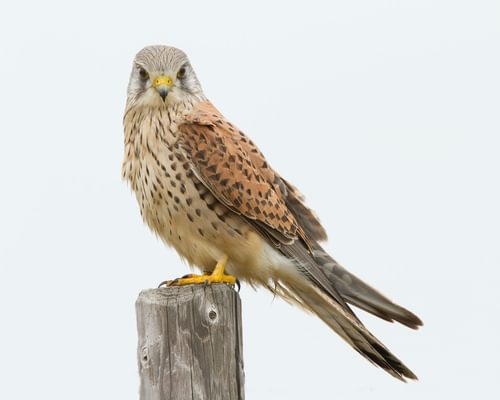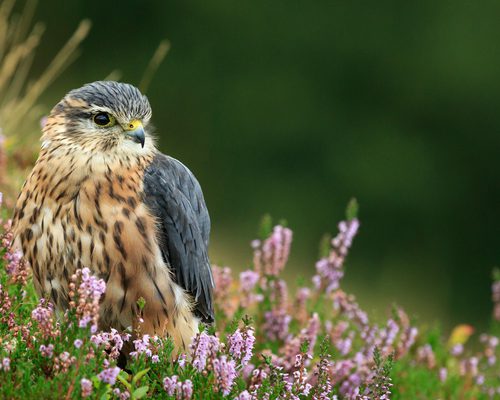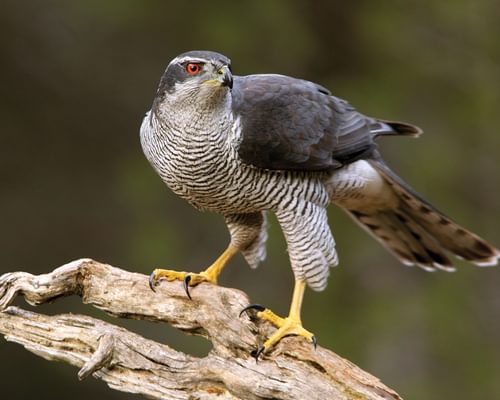Sparrowhawk
Least ConcernAccipiter nisus
Visual Identification
Appearance
The Sparrowhawk is a small, agile raptor with short, broad wings and a long tail. Males are predominantly bluish-grey above with orange-brown barring on the underparts. They have piercing yellow to orange eyes, hooked black beaks and yellow legs.
Females are significantly larger than males, with brown upperparts and brown barring on white underparts. Juveniles resemble females but have brown eyes and may show rufous edges to their back feathers.
Size
Length
28cm to 38cm
Wingspan
55cm to 80cm
Weight
110g to 340g
Habitat and Distribution
Habitats
Woodland
Garden
Wetland
Coastal
Urban
Farmland
Grassland
Desert
Tundra
Rainforest
Mountain
Savanna
Distribution
Sparrowhawks are widely distributed across Europe and Asia, from the British Isles to Japan and south to Tanzania in East Africa. They inhabit a variety of wooded habitats, including deciduous and coniferous forests, parks, and large gardens.
In the UK, Sparrowhawks are resident year-round and can be found in most areas with suitable woodland cover. Some northern populations may move south during harsh winters, while others remain in their breeding territories.
They are one of the UK's most common birds of prey, with a population estimated at over 60,000 mature individuals.
Elevation Range
Up to 4,500 meters
Climate zones
Temperate, Subarctic
Distribution Map
This map gives you a rough idea of where you might spot a Sparrowhawk. The coloured areas show countries where these birds have been seen.
A few things to keep in mind:
- Birds might not be everywhere in the coloured areas, for example, they may be present around the coast of that country
- Where birds live can change with seasons and available food
- This map is quite simple - it doesn't show exact locations
We're working on making our maps even better! Soon, we hope to show you:
- More detailed maps for bigger countries, including state and region
- How birds move around during different seasons
Distribution by Region
Behaviour and Ecology
Bird Attributes
This feature is in beta. We'd love your feedback to improve it!
Share your thoughtsBird Attributes Explained
Our bird attributes system rates various aspects of a bird's capabilities on a scale of 0-100, based on data from field observations, scientific studies, and expert knowledge.
Attribute Categories:
- Agility: Manoeuvrability, speed, and grace in flight or movement.
- Strength: Physical power, often correlating with size and hunting abilities.
- Adaptability: Ability to thrive in various environments or changing conditions.
- Aggressiveness: Territorial behaviour and assertiveness, particularly during breeding seasons.
- Endurance: Stamina, often seen in migration patterns or foraging behaviours.
Understanding the Ratings:
- 0-20: Very Low
- 21-40: Low
- 41-60: Average
- 61-80: High
- 81-100: Very High
Remember, these attributes are relative to other bird species and don't necessarily indicate superiority.
Hover over the icon next to each attribute for more information.
Tap the icon next to each attribute for more information.
Agility
Reflects the bird's manoeuvrability, speed, and grace in flight or movement.
The Sparrowhawk is renowned for its exceptional agility, particularly in woodland environments. Its ability to navigate swiftly through dense forest, perform elaborate aerial displays, and catch prey mid-flight demonstrates remarkable manoeuvrability and precision.
Strength
Indicates the bird's physical power, often correlating with size and hunting abilities.
While not the strongest raptor, Sparrowhawks possess considerable strength for their size. Females, being larger, are notably stronger. Their ability to carry prey and perform aerial acrobatics indicates good strength-to-weight ratio, though they're not as powerful as larger birds of prey.
Adaptability
Represents the bird's ability to thrive in various environments or changing conditions.
Sparrowhawks show high adaptability, thriving in various wooded habitats from forests to urban parks. Their recovery from pesticide-induced declines and ability to adjust to human-altered landscapes, even utilising gardens and bird feeders, demonstrates significant adaptability.
Aggressiveness
Measures the bird's territorial behaviour and assertiveness, particularly during breeding seasons.
Sparrowhawks are notably aggressive hunters, especially when pursuing prey. Their bold hunting tactics, including ambush techniques and high-speed chases, reflect a high level of aggression. However, they're not typically aggressive towards humans or larger animals.
Endurance
Reflects the bird's stamina, often seen in migration patterns or foraging behaviours.
While Sparrowhawks are capable of sustained hunting flights and can perform energy-intensive aerial displays during breeding season, their endurance is moderate compared to some migratory raptors. Their hunting style relies more on short bursts of speed and agility rather than prolonged pursuits.
Diet
Sparrowhawks primarily hunt small to medium-sized birds, with species like finches, tits, and thrushes forming the bulk of their diet. The smaller males generally eat birds like sparrows and tits, while the females can subdue larger prey like starlings, thrushes, and even pigeons.
They are skilled hunters, often catching prey in flight or by ambushing them in dense cover. Occasionally, they may take large insects or small mammals, like rodents, bats and reptiles.
Behaviour
Sparrowhawks are known for their swift, agile flight through woodlands. They often employ a 'flap-flap-glide' pattern when hunting, using cover to surprise prey.
During the breeding season, males perform spectacular sky dances, making steep dives and climbs to attract females.
Vocalisation
Sparrowhawks are generally silent outside the breeding season. During courtship and nesting, they become highly vocal and produce a rapid, high-pitched 'kew-kew-kew' call.
When alarmed, they emit a sharp, piercing 'kik-kik-kik'. Females have a louder, more guttural call compared to males.
Nesting & Breeding
Sparrowhawks typically breed between April and August. Males perform elaborate aerial displays to attract females, including high circles and steep dives. Once paired, they often reuse the same nesting site for years.
Nests are constructed by both sexes, usually in a fork of a tree near the trunk. They are made of twigs and lined with bark flakes. Females lay 4-6 pale blue eggs with brown speckles.
Incubation lasts about 33 days, primarily done by the female while the male provides food. Chicks fledge after 24-30 days but remain dependent on their parents for several weeks after leaving the nest.
Lifespan
The Sparrowhawk typically lives for 2 to 3 years, with a maximum recorded lifespan of 20.2 years.
Like all birds, lifespan can be affected by factors including predation, habitat quality, disease, and access to food sources.
Conservation and Status
Global Conservation Status
While currently listed as Least Concern, Sparrowhawks faced historical declines due to pesticide use in the mid-20th century.
They have since recovered in many areas but still face threats from habitat loss and illegal persecution. Ongoing monitoring is crucial to ensure their continued recovery.
Birdwatching Tips
- Look for Sparrowhawks in woodland edges or gardens, especially near bird feeders
- Listen for alarm calls from small birds, which often indicate a Sparrowhawk's presence
- Watch for their characteristic low, fast flight, with a few quick wingbeats, between trees
- In the UK, observe local parks or wooded areas during early morning or late afternoon
- Males tend to hunt more in woodland, females more in fields and open spaces
Additional Information
Quick Facts
Other names:
Eurasian Sparrowhawk
Family:
AccipitridaePredators
Adult Sparrowhawks have few natural predators, but they may fall victim to larger raptors like Goshawks or Eagle Owls. Nestlings and eggs are vulnerable to corvids, squirrels, and pine martens.
Did You Know?
- Sparrowhawks have exceptionally keen eyesight, estimated to be 8 times sharper than human vision.
- Female Sparrowhawks are up to 25% larger than males, one of the most pronounced size differences among raptors.
- They can catch prey in mid-air, demonstrating remarkable agility and speed.
- Only ten percent of the Sparrowhawk’s hunting attacks are successful.
- The Sparrowhawk is a sacred bird in Slavic mythology.
- The Sparrowhawk has been used in hunting for centuries.
Was this bird profile helpful?
Your feedback helps us improve our content
Thanks for your feedback!
Your input helps us improve our content.
Community Experience
Community Ratings
No ratings yet - be the first to rate this bird!
Latest Community Reviews
No reviews yet
Sign in to be the first to review
Community Reviews
Create Your Free Account Welcome Back!
Join our community to rate birds and share your experiences. Creating an account is completely free and only takes a minute. Sign in to your account to rate birds and share your experiences with our community.
Your information is secure and will never be shared.
By creating an account, you agree to our Privacy Policy.
FAQs
How fast can Sparrowhawks fly?
Sparrowhawks use speed and the element of surprise to catch their prey. They may reach speeds of up to 31 miles per hour (50 km/h) in the moments before they strike.
How do I stop Sparrowhawks from killing my garden birds?
The Sparrowhawk’s habit of catching garden birds can be rather upsetting to many bird lovers.
In this situation, the best thing to do is to place your feeders near dense cover to give the smaller birds a fighting chance at escape. Sparrowhawks need to eat regularly to survive, just like other birds, even if it may be difficult to watch.
Similar Birds
References
- 2 3 4
website: BirdLife International. 2021. Accipiter nisus. The IUCN Red List of Threatened Species 2021: e.T22695624A199751254.
View source - 1
website, 2010: Fransson et al., EURING list of longevity records for European birds
View source



